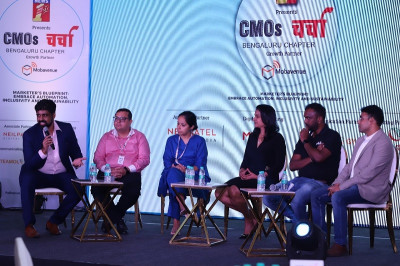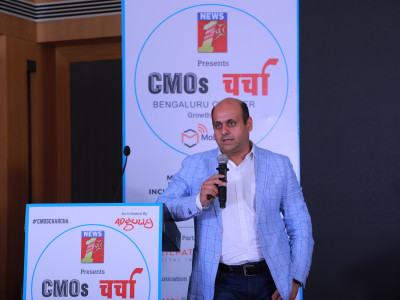70% of consumers now expect personalisation: Experts
The second edition of CMOs’ Charcha - Bengaluru Chapter 2023, held on October 6, 2023, brought together forward-thinking marketers, industry experts, and thought leaders. Presented by NewsFirst Kannada and hosted by Adgully, CMOs’ Charcha - Bengaluru Chapter 2023 is more than just a conference; it’s a celebration of the marketing industry’s innovation, resilience, and adaptability.
The theme this year was ‘Marketers’ Blueprint: Embrace Automation, Inclusivity, and Sustainability’. The theme reflects the current needs of the marketing industry, especially with the growing importance of automation and inclusivity in reaching diverse audiences. Innovation, of course, is always a key driver of success. The theme encapsulates the marketing industry's quest to adapt, connect, and thrive in an ever-evolving landscape. It’s a recognition that staying ahead in this field requires a multifaceted approach that respects the past, embraces the present, and constantly innovates for the future.
The event saw an interesting panel discussion on ‘Personalisation at Scale’, which was chaired by Manish Sridhar, Group Marketing Head, Quess Corp. The esteemed panellists included:
Vaibhav Puri, Vice President, Marketing, Nobroker.com
Jiten Mahendra, Chief Marketing Officer, Ample Technology
Ranjith Kumar, Head - Marketing, Digital & E-Commerce, Airasia
Meghna Apparao, Director, E-commerce & Retail (India), Meta
Taranjeet Kaur, Head of Media, Digital and PR, Tata Consumer
Manas Gupta, Consumer Marketing – Lead, Lenovo India
Manish Sridhar commenced the session by discussing the evolution of personalisation over the years. He stated, “Brands are accessing my data, enabling them to observe my online behaviour on social media, and customising content to aid me in making decisions in favour of their brand. The reason personalisation holds such a central role is that it facilitates brand acquisition. There has been a 40% increase in business attributed to personalisation, and 70% of consumers now expect personalisation. The framework for personalisation consists of four key aspects: how you access the data, how you segment the data to facilitate decision-making, how you design content tailored to individual consumers, and how you distribute content across various channels.”
Speaking on personalisation from an end-user perspective, Meghna Apparao noted, “Each one of us perceives or engages with a particular thing from entirely different viewpoints, and this is where personalisation comes into play. It lies at the core of everything. An example of content personalisation is that the same technology powers everything businesses seek to achieve. So, when we, as a business, aim to reach a specific shopper, we rely on personalisation, allowing these machines to make choices on our behalf.”
Taranjeet Kaur added here that Tata Consumers has been pioneers in creating hyper-local targeting. “Essentially, we produce distinct content for different states. We have a separate content creator for each state, ensuring it resonates effectively with the local market. Even our packaging is highly personalized, capturing insights specific to each state. This approach ensures that when someone picks up our product, they see something that resonates with their state,” she said.
Ranjith Kumar spoke about personalisation in the context of the airlines industry, stating, “In India, there are more than 500 aircraft. When we target the flying audience for the years 2022 and 2023, which encompass around 7 lakh passengers. Personalisation plays a crucial role in our communication strategy, especially after the BFSI sectors. It is essential for us to provide relevant and timely communications. It is about delivering the right message, whether it is about a flight delay or recommendations for a holiday. The goal is to remain connected and engage effectively with the right audience through personalised communication.”
Manas Gupta, focusing on the PC industry, said, “The key aspect of personalisation that we must consider is reaching the right audience. We must think of the customer journey from awareness to advocacy, encompassing awareness conversations and advocacy. On the other hand, we must acknowledge the mediums through which we engage with consumers, whether through awareness campaigns on various video platforms or individuals experiencing our products in stores and ultimately making purchase decisions. The entire proposition must be tailored to achieve different objectives.”
Vaibhav Puri added here, “We are transitioning from focusing on reach to prioritising relatability, with affinity becoming increasingly important. This is where personalisation gains significance. One of the key challenges that we encounter is that personalisation relies heavily on data and understanding consumers. Without a proper understanding of the consumer, the entire experience can go awry.”
These are edited excerpts. For the complete discussion, please watch below:


















Share
Facebook
YouTube
Tweet
Twitter
LinkedIn